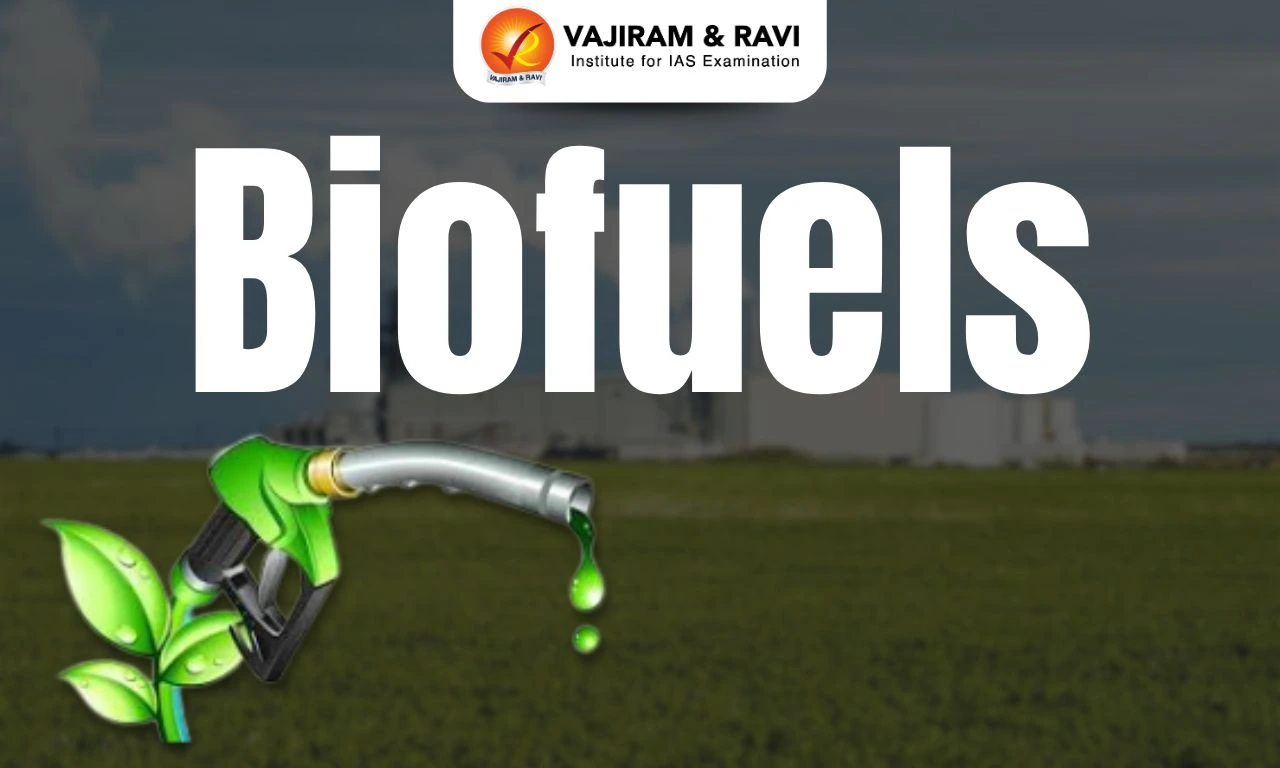Biofuel is a type of fuel that is generated naturally or artificially from the biomass of plant or algae material, and animal wastes. It is considered a renewable energy source because the feedstock material can be replenished easily. They can be in solid, liquid, and gaseous forms but the liquid biofuels have the most potential to replace conventional transportation fuels.
With rising crude oil prices, biofuels are seen as a sustainable alternative to be used mainly as a blending with petroleum-based fossil fuels. India also has set targets of 20% ethanol blending in petrol and 5% biodiesel blending in diesel by 2030 under the National Policy on Biofuels 2018.
Types of Biofuels
Many types of biofuels with different chemical compositions and physical properties are derived from biomass. They can replace traditional fossil fuels based on application suitability.

- Biodiesel: Biodiesel is a liquid fuel produced from vegetable oils and animal fats through transesterification.
- It is used as a replacement or as a blending with petroleum-based diesel in various combinations such as B5, B20, B100, etc.
- B20 (commonly used due to cost-effectiveness, low emissions and compatibility with conventional engines) is a blend containing 20% biodiesel and 80% petroleum diesel.
- B100 (less commonly used) is a pure biodiesel.
- Bioethanol: Bioethanol is ethyl alcohol (Ethanol) generated through microbial fermentation of plant materials like corn, sugarcane or agricultural residues using Saccharomyces cerevisiae.
- It is mainly used as a blending agent with petrol to increase octane and cut down carbon monoxide and other harmful emissions.
- E10 (10% ethanol mix) is the most commonly used blend, but other variations such as E-20 (blending target in India) are also used.
- E100 is pure ethanol and many countries including India are working on projects to use it as a replacement for petrol.
- Flexible fuel vehicles can run on up to 85% ethanol blends (E85).
- Biogas: Biogas is a renewable fuel produced by anaerobic digestion of organic matter, such as food or animal waste, in an oxygen-free environment, either naturally occurring or intentionally created for industrial use.
- It mainly consists of methane, with trace amounts of CO2 and H2S, etc.
- It is used for heating, power generation and vehicle fuelpurposes providing an alternative to natural gas.
- Upgraded biogas can also displace transportation and pipeline-quality natural gas.
- Bio CNG: Bio CNG is a purified form of biogas, processed to produce 95% pure methane gas, similar to commercially available natural gas.
- The process residue is a high-quality concentrated liquid fertilizer, and CO2 is measured and packed for food-grade CO2.
- Bio-CNG is profitable due to multiple revenue streams for organic liquid and solid fertilizers.
- It has a similar calorific value to Compressed Natural Gas (CNG) and involves commercial refining to increase methane content. The raw material is segregated biodegradable waste.
- Biobutanol: Biobutanol refers to butanol produced from the fermentation of biomass feedstocks such as starch.
- It is unmixable in water and has a higher energy content, It can be added to diesel to reduce emissions.
- The energy content in butanol is the highest among the other gasoline alternatives.
- Biojet fuel: Bio-jet fuel is aviation biofuel derived from biomass through various conversion processes such as Fischer-Tropsch synthesis or synthesized paraffinic kerosene (SPK) hydrotreating to yield a similar composition as conventional jet fuel.
- Benefits include reduced particulate emissions, carbon footprint and contrail formation with drop-in capability for existing aircraft fleets.
- However, availability constraints have restricted adoption to minor demonstration flights as of now.
- Renewable Diesel: Previously known as green diesel, chemically resembles petroleum diesel but is made from biomass feedstocks.
- It is produced by hydrotreating vegetable oils and waste oils in the presence of catalysts and hydrogen under high temperatures and pressure (similar to grease oil).
- This improves combustion efficiency compared to biodiesel while avoiding NOx emissions.
- It has superior storage stability and cold temperature operability than biodiesel and can directly replace diesel without engine modifications.
- Biochar: It is the spectrum of black carbon, produced by thecontrolled process - pyrolysis of organic materials from forests and agricultural wastes.
- It resembles normal wood charcoal.
- The main objective for the production of biochar is its use in carbon sequestration.
- It is speculated to have been used as a soil supplement in the Amazon basin thousands of years ago, where the regions of fertile soil known as "Terra Preta'" (dark earth), were created by the indigenous people.
- Bio-methanol: Bio-methanol or renewable methanol is chemically identical to conventional methanol but produced from syngas obtained from the gasification of renewable feedstocks like crop residues or wood waste. Still in the demonstration phase globally.
Other conceptual biofuel variants like bio-dimethyl ether, bio-synthetic natural gas, and biohydrogen may gain prominence in future.
Generations of Biofuels
Biofuels have evolved through different technological generations based on the type of organic feedstock used in the production:

| Generations | Key Characteristics |
| 1st Generation |
- First-generation biofuels are mainly derived from consumable food items such as starch, sugar, or vegetable oil. - They are also known as conventional biofuels, such as ethanol prepared by the fermentation of sugarcane or sugar beets.
|
| 2nd Generation |
- Second-generation biofuels are also called "olive green" or "cellulosic-ethanol" fuel. - They are mainly derived from sustainable or non-food feedstocks, such as waste vegetable oil, forest residue, industry residue, and sustainable biomass. |
| 3rd Generation |
- Third-generation biofuels are also known as "algae fuel" or "oilage," as they are produced from algae. - Algae can lead to the production of all types of biofuels, such as:-
|
| 4th Generation |
- These latest biofuels are generated by using genetic engineering of both organisms and feedstocks for higher yields. - Genetically modified algae and cyanobacteria are the main organisms to be used in the production of these biofuels. |
Advantages and Applications of Biofuels
Biofuels provide several technical, economic and environmental benefits that make them promising substitutes for conventional fossil fuels.
- Energy security: Encouraging domestic production of biofuels can help reduce dependence on imported fossil fuels, thereby enhancing energy independence and supply resilience.
- In India, the current E10 and E20 ethanol blending targets will help reduce the country's oil import burden by $4 billion per year while also supporting the sugar industry economically.
- Rural economy: Additionally, farmers can earn additional revenue by selling raw materials like grain, sugar, or oilseeds to biofuel manufacturers, and
- They can also generate extra income by cultivating agricultural residues and dedicated energy crops.
- Environmental gains: Biofuels recycle carbon during their lifetime, unlike fossil fuels that have been buried for a long time, and therefore utilising biofuels does not increase atmospheric CO2 if replantation sustains feedstock supplies.
- Furthermore, biofuels have lower particulate emissions.
- Biofuels burn cleaner with less sulfur and carbon monoxide emissions.
- Some biofuels such as biochar are being used for carbon sequestration in the soil.
- They will help India’s environmental programmes such as the Swachh Bharat Mission and Waste to Wealth Creation.
- Compatibility factor: To make bioethanol and biodiesel suitable for engines and distribution infrastructure, they can be combined with current petrol and diesel supplies.
- Biofuels are mainly used in transportation as a fuel substitute, but they can also be used in smaller applications such as captive power generation, off-grid electricity supply, and power backup.
- The aviation sector is investigating blends of biofuel to lessen their carbon footprint.
Disadvantages of Biofuels
There are numerous challenges to the development and harnessing of biofuels including the debate of food vs fuel, skewed cropping patterns, water stress market constraints etc.
- Food vs Fuel Debate: In the case of 1st and 2nd Generation Biofuels, using food crops like sugarcane and edible oilseeds for energy production may impact their availability for food consumption.
- India aims to achieve 20% ethanol blending with petrol by 2025-26, largely achieved through 1G ethanol from sugar cane and food grains.
- However, this large-scale cultivation may disrupt land use patterns, displacement of food crops, and increase water scarcity in water-stressed regions.
- Suboptimal crop residue management: Unsustainable removal of agricultural residues from the field can harm soil quality, water retention, and long-term productivity.
- Cost competitiveness: Biofuels like ethanol and biodiesel are not yet fully cost-competitive with petrol and diesel when considering production, distribution costs, and taxes/duties.
- Technological barriers:
- Second-generation biofuels still face challenges like high costs, low yields, feedstock logistics, etc., requiring further research and development improvements.
- In the case of 3rd and 4th generation, Algal feedstock growth requires overcoming challenges in maintaining optimal environments.
- 4th generation biofuel techniques are still being developed and face uncertainty around commercial scalability.
Global Initiatives for Biofuels
Globally, the use of biofuels is gaining importance due to growing concerns about energy security and the environment. Many countries are leading in the production and usage of biofuels such as Brazil (largest producer of bioethanol), EU (largest producer of biodiesel), USA, etc.
- Global Biofuel Alliance: Led by India, it was launched at the G20 summit and aims to develop an alliance of governments, international organisations, and industry to facilitate the adoption of biofuels.
- The alliance will focus on strengthening markets, facilitating global biofuels trade, developing concrete policy lesson-sharing, and providing technical support for national biofuels programs worldwide.
- Report on ‘Bioresources within a Net-Zero Emissions Economy’ (Energy Transitions Commission): It recommends prioritising the use of biomass in sectors where there are limited low-carbon alternatives.
- Roundtable on Sustainable Biomaterials (RSB): It is an international initiative that brings together stakeholders such as farmers, businesses, and governments who are interested in the sustainability of biofuel production and distribution.
- It prescribes the "RSB Certification System" as a set of comprehensive sustainability standards.
- Sustainable Biofuels Consensus: Itis an international initiative that aims to build collaboration among various stakeholders, including governments and the private sector, to ensure the sustainable production, trade, and use of biofuels.
- It facilitates global biofuels trade, transport, and biofuels markets.
Initiatives in India
The Indian Government has acknowledged the strategic role of biofuels in the Indian energy basket and prepared a road map to facilitate the early adoption of biofuels.
- National Policy on Biofuels - 2018 (amended in 2022): It aims at reducing dependence on imports by encouraging fuel blending.
- It emphasises the production of second-generation biofuels derived from forest and agricultural residues and increasing capacity for the production of fuel additives, and R & D in feedstock.
- As a part of the policy, Ethanol Blending Programme (EPB), is undertaken with an enhanced focus on bioethanol, biodiesel and bioCNG.
- It guides us to achieve the target of 20% ethanol blending in India by 2025-26.
- The National Biofuel Coordination Committee is the agency to coordinate this blending programme.
Last updated on November, 2025
→ Check out the latest UPSC Syllabus 2026 here.
→ Join Vajiram & Ravi’s Interview Guidance Programme for expert help to crack your final UPSC stage.
→ UPSC Mains Result 2025 is now out.
→ UPSC Notification 2026 is scheduled to be released on January 14, 2026.
→ UPSC Calendar 2026 is released on 15th May, 2025.
→ The UPSC Vacancy 2025 were released 1129, out of which 979 were for UPSC CSE and remaining 150 are for UPSC IFoS.
→ UPSC Prelims 2026 will be conducted on 24th May, 2026 & UPSC Mains 2026 will be conducted on 21st August 2026.
→ The UPSC Selection Process is of 3 stages-Prelims, Mains and Interview.
→ UPSC Result 2024 is released with latest UPSC Marksheet 2024. Check Now!
→ UPSC Prelims Result 2025 is out now for the CSE held on 25 May 2025.
→ UPSC Toppers List 2024 is released now. Shakti Dubey is UPSC AIR 1 2024 Topper.
→ UPSC Prelims Question Paper 2025 and Unofficial Prelims Answer Key 2025 are available now.
→ UPSC Mains Question Paper 2025 is out for Essay, GS 1, 2, 3 & GS 4.
→ UPSC Mains Indian Language Question Paper 2025 is now out.
→ UPSC Mains Optional Question Paper 2025 is now out.
→ Also check Best IAS Coaching in Delhi
Biofuels FAQs
Q1. What are biofuels?+
Q2. What are the policy initiatives taken by the Government of India concerning biofuels?+
Q3. What are the advantages of biofuels?+
Q4. What is the Global Biofuel Alliance?+

















